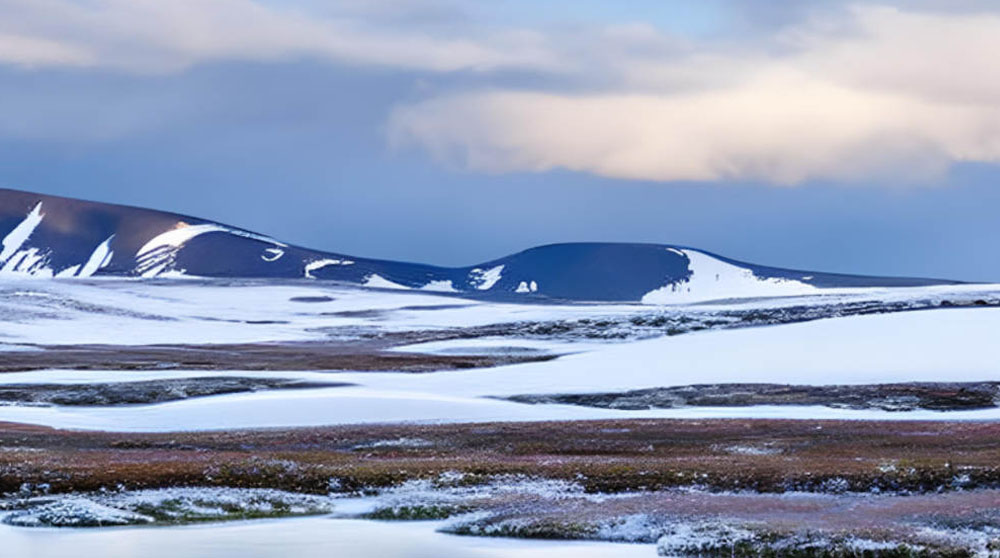
Subarctic climate corresponds to one of the climatic belts of the planet. Subarctic climate dominates in the Northern Hemisphere, and in the Southern Hemisphere at the same latitudes is subantarctic.
Definition
Subarctic climate is a type of climate, characteristic mainly for the subpolar regions of the Earth, bordering the Arctic zone in the north and the temperate zone in the south. The main feature of the subarctic climate is the short duration of climatic summer: even in the warmest month, the average air temperature does not exceed +15 °C. Winter is always long, depending on the location it can be either very severe or relatively mild.
Characteristics
The subarctic climate has a distinctive feature: it has long winters and short summers. The maximum temperature of the warmest month is +15 °C.
In winter, when Arctic air masses come from the pole, the air temperature drops. It can reach -60 degrees Celsius when it penetrates deep into the continents.
Precipitation is rare in the subarctic climate.
Subarctic climate is dominated by cyclones throughout the year (Arctic, winter Siberian, and North American cyclones that constantly replace each other).
Temperature
The area with a subarctic type of climate undergoes significant changes in air temperature depending on the time of year. In winter, the thermometer can drop to -45 degrees Celsius and below. Moreover, severe frosts can prevail for several months. In summer, the air warms up to 12-15 °C above zero.
The average air temperature varies depending on the natural zone and and distance the oceans: there is practically no summer in the tundra zone, the temperature in July is not more than +12 °C, the winter is long and frosty; in the taiga zone the summer season, although short-lived, is more clearly manifested.
Precipitation
Low temperatures do not saturate the air with moisture, as a result of which there is very little precipitation in the climatic zone. They fall out mainly in the summer. Nevertheless, due to low temperatures, precipitation still exceeds evaporation, and this affects the swampiness of the region.
On average, about 350-400 mm falls here annually. Compared to warmer areas, this value is quite small.
Precipitation varies depending on the natural zone and distance to the oceans. In tundra average precipitation is less than 300 mm, in the taiga zone, precipitation increases to 400 mm/yr.
Also the amount of precipitation depends on the height of a particular area above sea level. The higher the area is, the more rain falls on it. Thus, mountains located in a subarctic climate receive much more precipitation than plains and depressions.
Vegetation
Not all plants can survive a long winter with temperatures below 40 degrees and a short summer with little or no rain. Therefore, the territory with a subarctic climate has limited flora. There are no rich forests and, moreover, meadows with elevated grasses. However, the overall view of the species is quite high. Plants are dominated by mosses, reindeer moss, lichens, berries, and herbs. In the summer, it gives a dose of vitamin component to the diet of deer and other herbivores.
Coniferous trees form the basis of forests. Forests of the taiga type, quite dense and dark. In some areas, instead of coniferous species, dwarf birch is represented. Tree growth is very slow and is possible only for a limited period of time - during a short summer warming.
Animals
Areas influenced by the subarctic climate do not differ in the diversity of animals and birds. Typical inhabitants of these territories are the lemming, the Arctic fox, the ermine, the wolf, the reindeer, the snowy owl, and the ptarmigan.
The numbers of individual species are directly affected by weather conditions. And, because of the food chain, fluctuations in the numbers of some animals affect the populations of others. A striking example is the absence of egg clutches in the Arctic owl during the decline of lemming populations. This is because these rodents form the basis of the diet of this bird of prey.

Subarctic climate countries
The subarctic climate zone runs through the northern part of Canada, the Alaska Peninsula in the United States, the southern coast of Greenland, the northern regions of Iceland, the Scandinavian Peninsula - Finland and Norway, the Far East and Siberia in Russia.
Agriculture
Due to the specifics of the subarctic climate in territories with its influence, full-fledged agricultural activity is impossible. To obtain fresh vegetables and fruits, it is required to use artificial facilities with heating and lighting.
Human life
This type of climate is unfavorable for human habitation. The weather conditions are so severe that it is quite difficult to survive in these places. Historically, there have been populations of people who have adapted to the conditions of a certain type of climate. One of the largest is the Arctic adaptive type. This is the population that lives within the Arctic and subarctic climatic zones.
Adaptation of people to the subarctic climate takes a long time and is hard. It is difficult to build houses in the permafrost zone and frozen ground. Constant low temperatures and cold winters expose the body to frequent colds and other viral diseases, and long periods of polar nights negatively affect the nervous system.